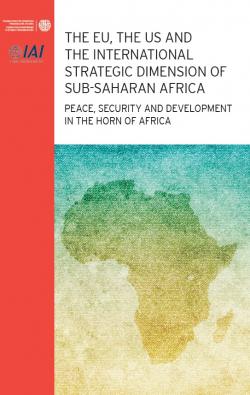The EU, the US and the International Strategic Dimension of Sub-Saharan Africa: Peace, Security and Development in the Horn of Africa
L’importanza strategica dell’Africa sub-sahariana è notevolmente aumentata negli ultimi decenni, con un impegno diversificato ma sempre più importante da parte di vari attori internazionali nella regione. Paesi come il Brasile, la Cina, gli stati del Golfo e la Turchia hanno una presenza significativa in Africa, e alcuni di loro hanno anche legami storici consolidati nella regione. Questa pubblicazione – che è il risultato finale di un progetto su “L’Ue, gli Usa e la dimensione strategica internazionale dell’Africa subsahariana: pace, sicurezza e sviluppo nel Corno d’Africa” – mira ad identificare il ruolo svolto da alcune potenze esterne chiave nel promuovere la pace, la sicurezza e lo sviluppo nell’Africa sub-sahariana. L’analisi presta attenzione al modo in cui i paesi africani costruiscono le proprie capacità per confrontarsi con più partner e la nuova posizione in cui vengono a trovarsi. Un’analisi specifica è dedicata inoltre al Corno d’Africa e alla Somalia in particolare. La pubblicazione fornisce inoltre raccomandazioni per le potenze esterne esaminate, con particolare attenzione a Unione europea e Stati Uniti.
Risultato del progetto “L’Ue, gli Usa e la dimensione strategica internazionale dell’Africa subsahariana: pace, sicurezza e sviluppo nel Corno d’Africa”.
Preface, by Ernst Stetter and Gianni Bonvicini, p. 9-11
Introduction, by Nicoletta Pirozzi and Bernardo Venturi, p. 13-17
1. Brazil as a Security and Development Provider in Africa: Consequences and Opportunities for Europe and North America, by Frank Mattheis, p. 19-40
1.1 Historical context
1.2 Relations after the Cold War
1.3 The role of Brazil in peace and security in Sub-Saharan Africa
1.4 The role of Brazil in development in Sub-Saharan Africa
1.5 Priorities and challenges of Brazil’s engagement in Sub-Saharan Africa
1.6 Recommendations for the EU and the US in the context of Brazil’s presence in Africa
2. China’s Relations with Sub-Saharan Africa, by Anna Katharina Stahl, p. 41-75
2.1 Introduction: China’s renewed diplomatic interest in Africa
2.2 China’s role as a development actor in SSA
2.2.1 Instruments and geographical coverage
2.2.2 Sectoral priorities
2.2.3 Guiding principles
2.2.4 China’s South-South cooperation with Africa
2.3 China’s growing contribution to African peace and security
2.4 Conclusion: The broader context of China’s engagement in SSA
2.4.1 China’s domestic priorities
2.4.2 Implications for the EU and the US
3. The Role of Gulf States in Peace and Security and Development in Sub-Saharan Africa, by Lidet Tadesse Shiferaw, p. 76-102
3.1 The role of the Gulf states in peace and security in SSA
3.1.1 The rise of the Gulf states as influential international and regional actors in SSA
3.1.2 The role of the Gulf states in peace and security in SSA
3.2 The role of the Gulf states in the economic development of SSA
3.2.1 GCC economic cooperation with SSA
3.2.2 GCC trade and investment in SSA
3.2.3 Main fields of impact and future prospects
3.2.4 Gulf investment controversies
3.3 Assessing main priorities and main challenges of the Gulf states
Recommendations
4. Turkey’s African Experience: From Venture to Normalization, by Mehmet Özkan, p. 103-123
4.1 Defining Turkey as an actor in Africa
4.2 The role of Turkey in peace and security in SSA
4.3 The role of Turkey in development in SSA
4.4 Priorities and challenges
Recommendations
5. The EU’s Struggle with Normative Leadership in Sub-Saharan Africa, by Bernardo Venturi, p. 124-151
5.1 EU engagement and relevance in the region
5.2 The role of the EU in peace and security issues in SSA
5.3 The role of the EU in development issues in SSA
5.4 The EU’s interaction with other international actors in SSA
5.4.1 The EU’s interaction with other international actors on peace and security
5.4.2 The EU’s interaction with other international actors on development cooperation
Conclusion: A comprehensive Africa policy for the EU
6. Security, Development, and Diplomacy: Solving the Puzzle of the US-Sub-Saharan Africa Strategy?, by Madeleine Goerg, p. 152-186
6.1 The evolution of the US’s engagement with SSA
6.2 The US as a peace and security actor in SSA
6.3 The US as a development actor in SSA
6.4 Recommendations for US and EU engagement with SSA
7. The Role of External Actors in Security and Development in the Horn of Africa: The Case of Somalia, by Rossella Marangio, p. 187-215
7.1 Security dynamics: Shifting towards holistic approaches
7.2 Development dynamics: The coordination game
Recommendations
8. Security and Development in Somalia: Attempts to Sustain Fragile Gains, by Cleophus Thomas III, p. 216-250
8.1 Security challenges
8.1.1 Lack of reliable and integrated security forces
8.1.2 Slow integration of security forces
8.1.2.1 ASWJ, Puntland, and Jubaland
8.2 Political and social reconciliation
8.2.1 AMISOM: Present and future
8.2.1.1 The future of AMISOM: A troubled transition?
8.3 Al-Shabaab and the jihadist threat
8.3.1 Mass raids
8.3.2 Civilian blockades
8.3.3 Future of al-Shabaab and regional implications
8.4 Trade, infrastructure, and food security
Conclusion and recommendations
Notes for Further Research, by Bernardo Venturi and Céline Guedes, p. 251-257
Contributors, p. 263-264
Abbreviations and Acronyms, p. 265-270
Tema
Tag
Contenuti collegati
-
Pubblicazione04/11/2016
The EU's Struggle with Normative Leadership in Sub-Saharan Africa
leggi tutto -
Pubblicazione08/09/2016
Security, Development, and Diplomacy: Solving the Puzzle of the US-Sub-Saharan Africa Strategy?
leggi tutto -
Pubblicazione08/09/2016
China's Relations with Sub-Saharan Africa
leggi tutto
- 1
- 2
- 3
- seguente ›
- ultima »




